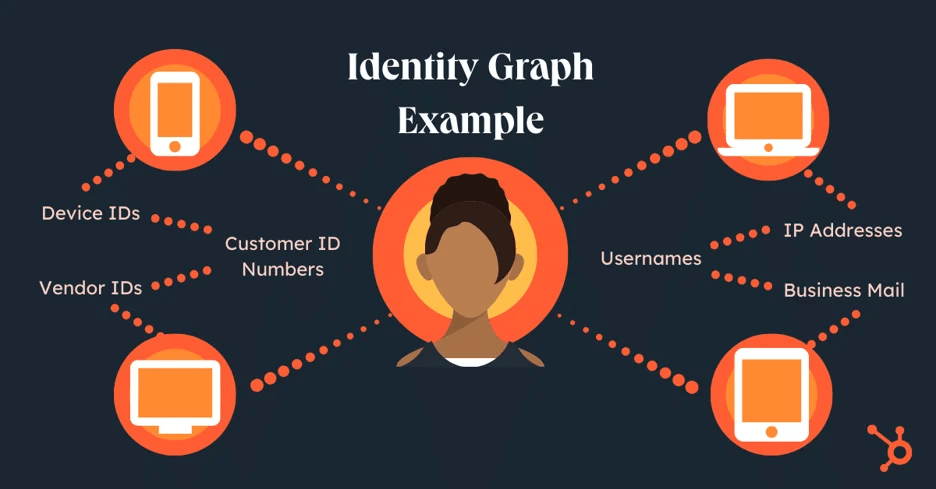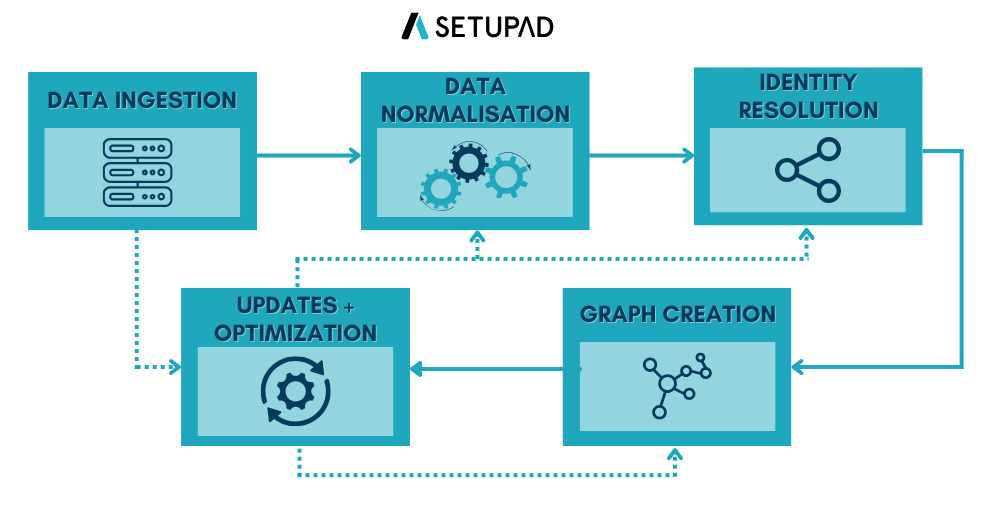7 Reasons Publishers Should Build Their Own Identity Graph
Introduction
With shifts in data privacy and the decline of third-party cookies, publishers are seeking solutions to optimize audience engagement and revenue. An identity graph—a tool for connecting and analyzing first-party data—offers publishers a way to create privacy-compliant strategies while unlocking new growth opportunities.
What is an Identity Graph?
An identity graph is a database structure that connects unique customer identifiers and user activities to a unified profile, enabling the association of historical and behavioral data with individual users.
Customer identifiers are distinct data points used to recognize individual users. These typically include details such as:
- Email address
- Phone number
- User ID
- Device ID
- Transaction ID
- Cookie ID
- Physical address
- ZIP code
An identity graph connects anonymous identifiers with known ones, continuously updating in real-time as new data is collected. Its primary goal is to provide the most accurate and current view of customers, enabling advanced personalization strategies.

Source: Hubspot
Purpose of Identity Graphs
Identity graphs consolidate customer data into unified profiles, enabling several valuable applications. They streamline analytics by providing insights into user behavior and preferences, facilitate accurate identity linking across multiple channels, and simplify customer journey mapping.
Additionally, they enhance audience segmentation for more effective marketing, support advanced personalization strategies, and strengthen data security and compliance through centralized data governance. These capabilities help businesses improve decision-making, deliver personalized experiences, and maintain robust data management practices.
How Are Identity Graphs Created and Maintained?
Building and maintaining an effective identity graph is a multi-step process that involves collecting, organizing, and continuously refining data to create a unified and actionable view of individual users.
This process is essential for publishers to deliver personalized experiences and optimize advertising strategies. The 5 key steps involved in creating and managing an identity graph are outlined below:
1. Data Ingestion
The foundation of an identity graph starts with aggregating data from various high-quality and relevant sources. This includes both first-party data (from websites, apps, CRM systems, and offline interactions) and third-party data (from external partners or data providers). Data sources can span behavioral data, transaction history, device information, cookies, and consented user identifiers. The goal is to collect comprehensive data to capture every touchpoint of the customer journey.
2. Data Normalization
Once data is collected, it must be cleaned, structured, and standardized to ensure consistency and accuracy. This process involves deduplication, correcting errors, and converting data into a uniform format so that disparate datasets can be effectively integrated.
Without proper normalization, mismatched data formats and inconsistent identifiers can lead to inaccurate user profiles, reducing the effectiveness of targeting and personalization efforts.
3. Identity Resolution
Identity resolution is the core of building an identity graph. This step involves matching and merging fragmented data points across devices, platforms, and channels to form a single, cohesive user profile. This can include connecting device IDs, cookies, hashed emails, and login data.
Advanced identity resolution uses deterministic methods (exact matches like email logins) and probabilistic methods (pattern-based matching like IP addresses, device types) to improve accuracy. Privacy-first solutions ensure that identity resolution respects user consent and data protection laws.
4. Graph Creation
After resolving identities, the next step is building the actual graph. In this structure, each user is represented as a node, and the relationships between their data points (devices, behaviors, interactions) are depicted as edges. This interconnected structure enables a scalable and dynamic system for understanding user behavior and preferences.
Identity graphs can be customized based on business goals—some prioritize deterministic data for precision, while others blend deterministic and probabilistic data for broader audience reach.
5. Updates and Optimization
An identity graph is not static; it requires continuous updates to stay relevant. This involves real-time data integration, regular cleansing to remove outdated information, and optimization to adapt to evolving privacy regulations and technology shifts. Continuous refinement ensures the graph delivers accurate, timely insights.

Reasons Publishers Should Build Their Own Identity Graph
1. Deeper Understanding of Your Audience
An identity graph integrates diverse data sources—email, web, apps—into a unified view of your audience. This helps publishers identify key demographics, behaviors, and preferences across platforms. Enriched data provides insights into user engagement, informing both editorial strategies and ad targeting. For example, combining identity graphs with behavior data can uncover content consumption trends that boost engagement.
2. Building Actionable Audience Segments
Publishers often have a significant portion of anonymous visitors. Identity graphs help resolve these unknown users into identifiable profiles, enabling the creation of targeted segments.
By leveraging audience segmentation, publishers can define niche audiences, showcase their value to advertisers, and make strategic decisions around data planning and activation. Comprehensive ID graphs revolutionize audience activation, especially for audio platforms and TV networks, where segmenting users based on listening or viewing habits leads to highly targeted ad placements, both direct and programmatic.
Ensuring interoperability within an ID graph streamlines audience activation, allowing publishers to easily onboard customer segments onto ad platforms. Digital publishers can activate audiences on-site using SDKs or through ad server integrations, simplifying tech stacks and easing the workload for data teams.
3. Finding Your Next Best Customers
Using insights from identity graphs, publishers can model lookalike audiences to attract new users with similar behaviors and interests. By understanding what content drives engagement both on and off their platforms, publishers can expand their audience reach. For example, identifying the top-performing content categories helps target new users with comparable preferences.
4. Transforming Data into Revenue
An identity graph empowers publishers to sell enriched audience data directly to advertisers or integrate it into demand-side platforms. By avoiding costly data collaborations or reliance on walled gardens, publishers can maximize their revenue potential. Tailored audience segments allow publishers to charge premium rates for direct-sold campaigns, boosting eCPMs and revenue.
5. Future-Proofing Against Privacy Changes
As privacy regulations evolve and third-party cookies are deprecated, identity graphs offer a sustainable solution. By relying on deterministic, consented first-party data, publishers can maintain compliance while ensuring their data remains actionable. This future-proof approach ensures ongoing audience targeting capabilities without privacy concerns.
6. Boost Advertiser Relationships
Data collaboration has become a priority for publishers aiming to work with advertising partners in a privacy-compliant manner to develop and activate data-driven campaigns.
Using first-party data for collaboration leads to highly accurate and effective advertising, benefiting all stakeholders.
7. Boost Programmatic Revenue with ID Bridging
ID bridging enables publishers to increase inventory value on programmatic platforms. By enriching bid requests with additional identifiers, publishers improve audience addressability for advertisers. This leads to higher bid density and increased programmatic revenue.
ID bridging is an effective data monetization tactic, helping media companies build sustainable audiences and generate consistent revenue from premium ad space, especially in the post-cookie era.

How to Start Building Your Identity Graph?
To build an effective identity graph, publishers should begin by consolidating all relevant data from all sources—both online and offline—into a centralized data warehouse. The next step involves preparing the data by defining, organizing, and linking customer profiles, which requires creating a robust identity resolution framework.
This process can be complex, as it involves transforming data and establishing rules for connecting profiles. There are solutions designed to simplify the creation of a robust identity resolution framework. One effective approach is using warehouse-native identity resolution platforms like Hightouch or Segment. These tools operate directly on top of a company’s existing data warehouse. For publishers wanting more control over their data and identity resolution logic, a warehouse-native solution is better suited.
However, other identity resolution can also be a good choice for enhancing cross-platform audience activation. For example, LiveRamp IdentityLink operates as an external data connectivity and identity resolution platform. Publishers send their first-party data to LiveRamp, which then matches and enriches that data with external identifiers before distributing it to demand platforms.
Additionally, tools like Prebid, which integrates identity resolution for programmatic advertising through identity modules and operates on the client-side or within the ad tech stack, simplify the process and allow publishers to enhance ad targeting and audience engagement and revenue generation with minimal effort.
Overcoming Common Challenges in Building Your Identity Graph
Challenge 1: Adding New Data Sources
The Problem:
Incorporating new data sources into an ID graph can be a complex and time-intensive process. Customer Data Platforms (CDPs) often lack the flexibility needed to ingest diverse and evolving data inputs, particularly from on-site interactions. Moreover, second-party data requires thorough cleansing and normalization to ensure it is accurate and usable. This step adds layers of complexity and slows down the process, making it difficult to keep the ID graph current and comprehensive.
The Solution:
Publishers should collaborate with technology providers like LiveRamp, Neustar, and Optable that offer specialized managed services for data onboarding, cleaning, and normalization. These partners bring expertise and scalable solutions to streamline data integration, ensuring seamless ingestion of both first-party and second-party data. Additionally, consultative partners can tailor their services to a publisher’s specific data ecosystem, aligning the ID graph with the needs of multiple departments—whether for editorial strategy, marketing, or audience monetization.
Challenge 2: Maximizing Usability of the ID Graph
The Problem:
An ID graph must be adaptable to serve various organizational functions, but achieving this flexibility can be difficult. Different use cases demand unique graph structures, normalization rules, and linking processes. For example, identifiers such as email addresses, cookies, or mobile device IDs require customized handling. Engineering teams often invest considerable time and resources in building and testing custom solutions to fit these diverse needs, leading to high costs and inefficiencies.
The Solution:
Publishers should invest in platforms that offer dynamic and flexible tools for constructing and modifying ID graphs. Notable mentions include Segment and Hightouch. These solutions support easy ingestion of new data sources—whether through SDKs or direct cloud storage integration—and allow for on-the-fly adjustments to graph structures. This flexibility enables publishers to adapt their ID graphs to different use cases, from targeted advertising to subscription marketing automation and audience lifetime value analysis. Ultimately, this maximizes the addressability of the audience and ensures the ID graph remains a valuable asset across the entire organization.
Challenge 3: Integrating New Endpoints for Data Activation
Effective identity resolution is not just about managing data—it’s about activating it in real time. However, integrating ID graphs with ad platforms, marketing automation tools, and internal business intelligence systems can be challenging. Data warehouse-only solutions often involve cumbersome, multi-step processes to move data between systems, slowing down the ability to act on insights. This lag prevents publishers from delivering timely, relevant content and ads to their audiences.
The Solution:
To overcome this bottleneck, publishers should adopt audience management platforms that offer built-in, purpose-driven integrations with advertising, marketing, and analytics endpoints, such as Salesforce Audience Studio, Oracle BlueKai, and Adobe Audience Manager. These platforms simplify and accelerate the connection between ID graphs and activation channels, allowing for seamless real-time audience targeting and campaign execution. Fast and reliable integrations ensure that publishers can quickly translate data insights into meaningful actions, such as dynamic ad targeting or personalized content delivery, ultimately improving campaign performance and operational efficiency.
Conclusion
Building an identity graph transforms how publishers interact with their audience. From deeper insights and audience growth to increased monetization and privacy compliance, the benefits are undeniable. By leveraging deterministic, consented data, publishers can future-proof their strategies while delivering exceptional user experiences and driving revenue.


